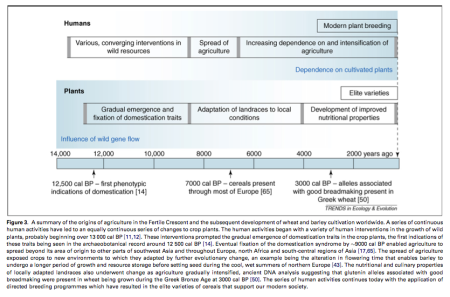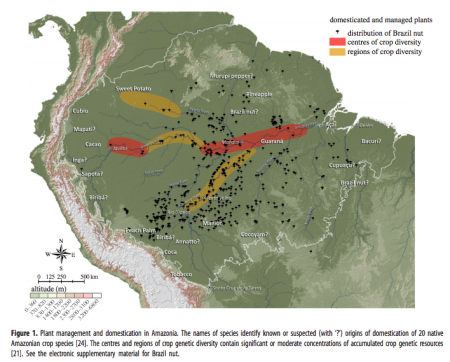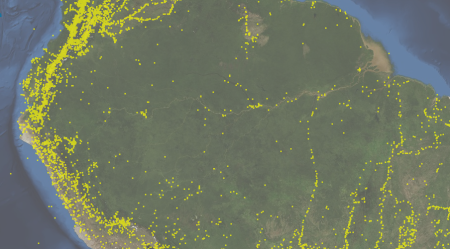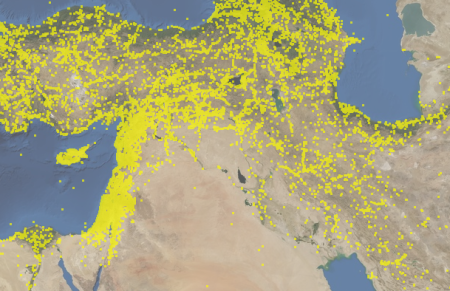- Traditional foods fight Native American obesity.
- Round Table on Responsible Soy makes some nice maps.
- The Decade for African Seas and Oceans is off to a blue start.
- Face it, academics, social media are good for you.
- You think Pres. Obama checked out some Nairobi street food?
- Pics of coffee value chain. Wow, that makes it sound really boring.
- Calling bullshit on farm to fork.
- A day in the life of an archeologist of Iron Age horses.
- Kava reaches NYC hipsters.
- Plantae is coming!
- Rice plants colonized by mychorriza express different genes and have more lateral roots.
Brainfood: Pepper tree conservation, Buckwheat diversity, Seed drying, Grape database, Livestock improvement, Soil bacterial diversity, TLB in Nigeria, Humans & diversity double, Faidherbia @ICRAF
- Genetic structure and internal gene flow in populations of Schinus molle (Anacardiaceae) in the Brazilian Pampa. Try to keep what forest patches remain. And link them up somehow.
- Genetic Diversity of Buckwheat Cultivars (Fagopyrum tartaricum Gaertn.) Assessed with SSR Markers Developed from Genome Survey Sequences. Two groups, overlapping in Qinghai, China.
- Increases in the longevity of desiccation-phase developing rice seeds: response to high-temperature drying depends on harvest moisture content. Genebanks may have it wrong for seeds of rice (and perhaps other tropical species) harvested while still metabolically active: these you can dry at higher temperatures than is the norm.
- Vitis International Variety Catalogue (VIVC): A cultivar database referenced by genetic profiles and morphology. Now with added microsatellites.
- Options for enhancing efficiency and effectiveness of research capacity for livestock genetics in, and for, sub-Saharan Africa. Embed in wider rural development, collaborate, and share data. Could apply to more than just livestock improvement.
- Mapping and validating predictions of bacterial biodiversity using European and national scale datasets. It’s the pH.
- Agricultural Extension Roles towards Adapting to the Effects of Taro Leaf Blight (Tlb) Disease in Nsukka Agricultural Zone, Enugu State. Basically, extensionists haven’t done a thing.
- Anthropogenic drivers of plant diversity: perspective on land use change in a dynamic cultural landscape. Abandoning farmland is not good for biodiversity.
- Agricultural landscapes and biodiversity conservation: a case study in Sicily (Italy). Ahem. Abandoning farmland is not good for biodiversity.
- Genetic diversity of Faidherbia albida (Del.) A. Chev accessions held at the World Agroforestry Centre. It’s not enough.
Early agriculture in the Old and New Worlds
Last week saw the publication of a couple of papers about early agriculture in two very different regions which will probably have people talking for quite a while. From Snir et al. 1 came a study of pre-Neolithic cultivation in the Near East. And from the other side of the world, there was the latest in the controversy over the extent of Amazonian agriculture from Clement et al. 2.
Yes, I did say pre-Neolithic. The key finding of the archaeological work described by the first paper is that 23,000 years ago, or over 11 millennia before the putative start of agriculture in the Fertile Crescent, hunter-gatherers along the Sea of Galilee in what is now Israel maintained little — and, crucially, weedy — fields of cereals. The archaeobotanists found remains of both the weeds and the cereals at a site called Ohalo II, as well as of sickles, and the cereals were not entirely “wild”, as the key domestication indicator of a non-brittle rachis was much more common than it should have been. To see what this means, have a look at this diagram from a fairly recent paper on agricultural origins in the region. 3

Those “first phenotypic indications of domestication”, dated at 12,500 years ago, need to be pushed quite a bit leftwards on that timeline now, off the edge in fact. A non-shattering rachis, it seems, was quite a quick trick for wild grasses to learn. But the process by which they acquired all the other traits that made them “domesticated” was very protracted and stop-start.
Zoom over to Amazonia, and the transition to farming took place much later, probably around 4,000 years ago, according to the other paper published last week. But it was just as significant as in the much better-known “cradle of agriculture” in the Fertile Crescent, with perhaps 80 species showing evidence of some domestication. The difference, of course, is that Amazonian agriculture was based on trees, rather than annual grasses and legumes.

According to the authors, parts of the Amazon basin, in particular those now showing evidence of earthworks and dark, anthropogenic soils, were just as much managed landscapes by the time of European contact as the places those Europeans came from. But compare our collections of crop diversity from the Amazon basin (courtesy of Genesys, which admittedly does not yet include Brazilian genebanks)…

with what we have from the Near East…

If we want to know more about how the domestication process and transition to agriculture differed in the Amazon and the Fertile Crescent, there’s a whole lot of exploration still to do.
Nibbles: Oz vineyard apocalypse, California vineyards redux, Ethiopian genebank, Maya collapse revisionism, SunBlack tomato, Nutritious staples, Citrus endowment, Sheep pix
- In Australia, they’re ripping up vineyards.
- Whereas in California, they’re going to breed 10,000 new grape varieties and make a new wine. Go figure.
- Interview with the director of the Ethiopian national genebank, Dr Gemedo Dalle.
- Deforestation et al. not responsible for Maya collapse after all. Jared Diamond unavailable for comment.
- Black tomato a hit in Italy. Looks crap on pizza though.
- The case for biofortification.
- University of Florida sets up endowment to protect its research groves in face of citrus greening.
- Googlesheepview. Nuff said.
Brainfood: Grassland diversity, Potato diversity, English CWR, Genetic rescue, Saffron diversity, Lac, Cereal domestication, Turkish pea, Pathogen genomes, Rose fragrance, African cheese
- Worldwide evidence of a unimodal relationship between productivity and plant species richness. Grassland richness maximal at intermediate productivity levels.
- Cytoplasmic genome types of European potatoes and their effects on complex agronomic traits. Interesting relationships between cytoplasmic type on one hand and tuber starch content and resistance to late blight on other.
- Enhancing the Conservation of Crop Wild Relatives in England. 148 priority species, half of them not in ex situ at all. But there’s no excuse for that now.
- Genetic rescue to the rescue. Meaning an increase in population fitness, especially of rare species, owing to new alleles. Genomics will help by choosing the new alleles better, and monitoring the results.
- Diversity and relationships of Crocus sativus and its relatives analysed by IRAPs. No variation in the allotriploid cultigen, lots in the closely related species. Let the resynthesis begin.
- Economic analysis of Kusmi lac production on Zizyphus mauritiana (Lamb.) under different fertilizer treatments. That would be the scarlet resin secreted by some insects. NPK needed. No word on genetic differences.
- Parallel Domestication of the Heading Date 1 Gene in Cereals. Same QTL in sorghum, foxtail millet and rice, but different alterations of it. Multiple domestication for sorghum, single for foxtail millet.
- DNA based iPBS-retrotransposon markers for investigating the population structure of pea (Pisum sativum) germplasm from Turkey. No geographic structure for the landraces.
- The two-speed genomes of filamentous pathogens: waltz with plants. Fungi and oomycetes quite different genetically, but both have regions of genome which change rapidly to make them good pathogens. Bastards.
- The flowering of a new scent pathway in rose. Can we have our nice-smelling roses back now, please?
- AFLP assessment of the genetic diversity of Calotropis procera (Apocynaceae) in the West Africa region (Benin). Not just a weed, used in cheese-making, of all things.